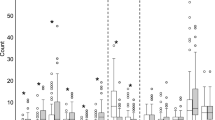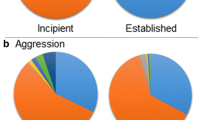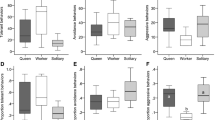Summary
-
1.
The form of normal groups ofMyrmica rubra has been studied in artificial nests consisting of a single tier of cells. An envelope of workers spreads out and covers the queens and brood leaving a cortex composed only of workers that functions as a defensive zone and a zone in which prey are prepared for ingestion. The cortex is especially well developed near the entrance. As the egg cluster grows, it breaks up, often with worker help and releases larvae; when these are ready to pupate the workers take them back into the central core of non-feeding brood and queens.
-
2.
The sociability of queens varies from those that are often alone, to those that are rarely alone and spend most of their time with other queens. Sociable queens may be very specific in the individuals they associate with or very indifferent to their companions. All the queens lay eggs in variable numbers but the quantity is not related to their sociability.
Resume
-
1.
La distribution des individus de groupes normaux deMyrmica rubra a été étudiée dans des nids artificiels formés d'une seule rangée de cellules. Une couche d'ouvrières recouvre les reines et le couvain, ménageant cependant une région périphérique où l'on ne trouve que des ouvrières dont le rôle est de défendre l'entrée et de préparer les proies pour la consommation. La région périphérique est particulièrement bien représentée, près de l'entrée. Lorsque le paquet d'œufs grossit, l'enveloppe d'ouvrières se dissocie et découvre les larves; lorsque ces dernières sont prêtes à se nymphoser, les ouvrières les ramènent vers le centre où se trouvent le couvain non alimenté et les reines.
-
2.
La sociabilité des reines est très variable. Certaines restent seules la plupart du temps alors que d'autres sont rarement solitaires et se regroupent avec d'autres reines. Certaines des reines sociables peuvent être très attentives au choix de leurs compagnes alors que d'autres sont tout à fait indifférentes à leur voisinage. Toutes les reines pondent des œufs en nombre variable sans rapport avec leur degré de sociabilité.
Similar content being viewed by others
References
Abraham M., Pasteels J.M., 1980. — Social behaviour during nest moving in the antMyrmica rubra L.Ins. Soc., 27, 127–147.
Brian M.V., 1956. — Group form and causes of working inefficiency in the antMyrmica rubra L.Physiol. Zool., 29, 173–194.
Brian M.V., 1969. — Male production in the antMyrmica rubra L.Ins. Soc., 16, 249–268.
Brian M.V., 1986. — Bonding between workers and queens in the ant genusMyrmica. Anim. Behav., in press.
Brian M.V., Hibble J., 1964. — Studies of caste differentiation inMyrmica rubra L. 7. caste bias queen age and influence.Ins. Soc., 11, 223–238.
Brian M.V., Rigby C., 1978. — The trophic eggs ofMyrmica rubra L.Ins. Soc., 25, 89–110.
David F.N., 1949. —Probability theory for statistical methods, Cambridge University Press, Publ. Cambridge, 230 p.
Evesham E.J.M., 1982. — Regulation of the production of female sexual morphs in the antMyrmica rubra L.Ph. D. Thesis, University of Southampton.
Evesham E.J.M., 1984. — Queen distribution movements and interactions in a seminatural nest of the antMyrmica rubra L.Ins. Soc., 31, 5–19.
Kelly A.F., 1973. — High densities and brood rearing in the antMyrmica rubra L.Ins. Soc., 20, 109–124.
Mamsch E., 1965. — Regulation der Fruchtbarkeit von Ameisenarbeiterinnen ohne Konigin und ohne Koniginsubstanz.Naturwiss., 52, 168.
Mamsch E., 1967. — Quantitativen Untersuchungen zur Regulation der Fertilität im Ameisenstaat durch Arbeiterinnen, Larven und Koniginnen.Z. Vergl. Physiol., 55, 1–25.
Smeeton L., 1980. — Male production in the antMyrmica rubra L.Ph. D. Thesis, University of Southampton.
Smeeton L., 1981. — The source of males inMyrmica rubra L.Ins. Soc., 28, 263–278.
Sommeier M.J., deBruijn L.L.M., 1983. — Social behaviour of stingless bees: “beedances” by workers of the royal court and rhythmicity of the brood cell provisioning and oviposition behaviour.Doctoral Thesis, University of Utrecht.
Author information
Authors and Affiliations
Rights and permissions
About this article
Cite this article
Brian, M.V. The distribution, sociability and fecundity of queens in normal groups of the polygyne antMyrmica rubra L.. Ins. Soc 33, 118–131 (1986). https://doi.org/10.1007/BF02224592
Received:
Accepted:
Issue Date:
DOI: https://doi.org/10.1007/BF02224592




